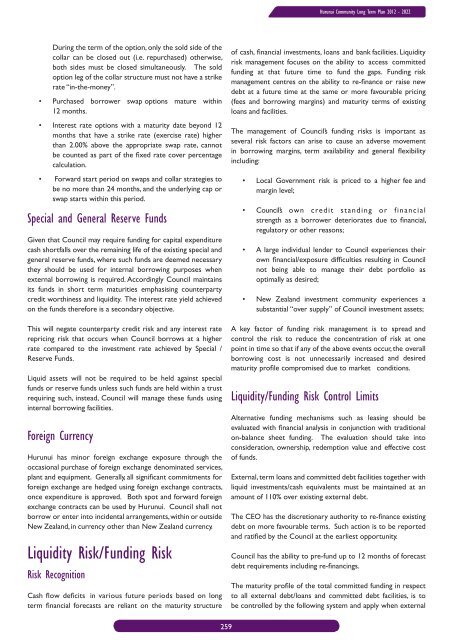Long Term Community Plan 2012-2022 - Hurunui District Council
Long Term Community Plan 2012-2022 - Hurunui District Council
Long Term Community Plan 2012-2022 - Hurunui District Council
You also want an ePaper? Increase the reach of your titles
YUMPU automatically turns print PDFs into web optimized ePapers that Google loves.
<strong>Hurunui</strong> <strong>Community</strong> <strong>Long</strong> <strong>Term</strong> <strong>Plan</strong> <strong>2012</strong> - <strong>2022</strong><br />
During the term of the option, only the sold side of the<br />
collar can be closed out (i.e. repurchased) otherwise,<br />
both sides must be closed simultaneously. The sold<br />
option leg of the collar structure must not have a strike<br />
rate “in-the-money”.<br />
• Purchased borrower swap options mature within<br />
12 months.<br />
• Interest rate options with a maturity date beyond 12<br />
months that have a strike rate (exercise rate) higher<br />
than 2.00% above the appropriate swap rate, cannot<br />
be counted as part of the fixed rate cover percentage<br />
calculation.<br />
• Forward start period on swaps and collar strategies to<br />
be no more than 24 months, and the underlying cap or<br />
swap starts within this period.<br />
Special and General Reserve Funds<br />
Given that <strong>Council</strong> may require funding for capital expenditure<br />
cash shortfalls over the remaining life of the existing special and<br />
general reserve funds, where such funds are deemed necessary<br />
they should be used for internal borrowing purposes when<br />
external borrowing is required. Accordingly <strong>Council</strong> maintains<br />
its funds in short term maturities emphasising counterparty<br />
credit worthiness and liquidity. The interest rate yield achieved<br />
on the funds therefore is a secondary objective.<br />
This will negate counterparty credit risk and any interest rate<br />
repricing risk that occurs when <strong>Council</strong> borrows at a higher<br />
rate compared to the investment rate achieved by Special /<br />
Reserve Funds.<br />
Liquid assets will not be required to be held against special<br />
funds or reserve funds unless such funds are held within a trust<br />
requiring such, instead, <strong>Council</strong> will manage these funds using<br />
internal borrowing facilities.<br />
Foreign Currency<br />
<strong>Hurunui</strong> has minor foreign exchange exposure through the<br />
occasional purchase of foreign exchange denominated services,<br />
plant and equipment. Generally, all significant commitments for<br />
foreign exchange are hedged using foreign exchange contracts,<br />
once expenditure is approved. Both spot and forward foreign<br />
exchange contracts can be used by <strong>Hurunui</strong>. <strong>Council</strong> shall not<br />
borrow or enter into incidental arrangements, within or outside<br />
New Zealand, in currency other than New Zealand currency.<br />
Liquidity Risk/Funding Risk<br />
Risk Recognition<br />
Cash flow deficits in various future periods based on long<br />
term financial forecasts are reliant on the maturity structure<br />
of cash, financial investments, loans and bank facilities. Liquidity<br />
risk management focuses on the ability to access committed<br />
funding at that future time to fund the gaps. Funding risk<br />
management centres on the ability to re-finance or raise new<br />
debt at a future time at the same or more favourable pricing<br />
(fees and borrowing margins) and maturity terms of existing<br />
loans and facilities.<br />
The management of <strong>Council</strong>’s funding risks is important as<br />
several risk factors can arise to cause an adverse movement<br />
in borrowing margins, term availability and general flexibility<br />
including:<br />
• Local Government risk is priced to a higher fee and<br />
margin level;<br />
• <strong>Council</strong>’s own credit standing or financial<br />
strength as a borrower deteriorates due to financial,<br />
regulatory or other reasons;<br />
• A large individual lender to <strong>Council</strong> experiences their<br />
own financial/exposure difficulties resulting in <strong>Council</strong><br />
not being able to manage their debt portfolio as<br />
optimally as desired;<br />
• New Zealand investment community experiences a<br />
substantial “over supply” of <strong>Council</strong> investment assets;<br />
A key factor of funding risk management is to spread and<br />
control the risk to reduce the concentration of risk at one<br />
point in time so that if any of the above events occur, the overall<br />
borrowing cost is not unnecessarily increased and desired<br />
maturity profile compromised due to market conditions.<br />
Liquidity/Funding Risk Control Limits<br />
Alternative funding mechanisms such as leasing should be<br />
evaluated with financial analysis in conjunction with traditional<br />
on-balance sheet funding. The evaluation should take into<br />
consideration, ownership, redemption value and effective cost<br />
of funds.<br />
External, term loans and committed debt facilities together with<br />
liquid investments/cash equivalents must be maintained at an<br />
amount of 110% over existing external debt.<br />
The CEO has the discretionary authority to re-finance existing<br />
debt on more favourable terms. Such action is to be reported<br />
and ratified by the <strong>Council</strong> at the earliest opportunity.<br />
<strong>Council</strong> has the ability to pre-fund up to 12 months of forecast<br />
debt requirements including re-financings.<br />
The maturity profile of the total committed funding in respect<br />
to all external debt/loans and committed debt facilities, is to<br />
be controlled by the following system and apply when external<br />
259

















